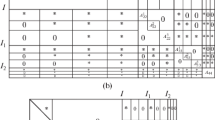Abstract
This paper presents a parallel triangular decomposition algorithm for banded symmetric matrices and its application to structural vibration analysis, which gives high rates of parallel efficiency on a workstation network. In case of decomposition of a matrix with halfbandwidth 822, the working efficiency rate was 84% using a network of six workstations (SUN SparcStation 20s). The algorithm provides a high rate of working efficiency in parallel environment with local memory, even if the communication time is considerably longer than the operation time.
As an application of the algorithm, a finite element (FE) system for structural vibration analysis with the parallel decomposition algorithm was developed on the above workstation network and a model with more than 100,000 degrees of freedom (DOFs) was successfully analyzed by the system. The computation time for the model with 10,752 DOFs and halfbandwidth 822 was 3,661 sec by the present parallel system, whereas the computation time by a single workstation was 14,335 sec.
Similar content being viewed by others
Author information
Authors and Affiliations
Rights and permissions
About this article
Cite this article
Aoyama, Y., Hirama, K. & Yagawa, G. A parallel triangular decomposition algorithm on a workstation network with application to structural vibration analysis. Computational Mechanics 19, 411–419 (1997). https://doi.org/10.1007/s004660050189
Issue Date:
DOI: https://doi.org/10.1007/s004660050189




